Warning: Undefined array key "ssba_bar_buttons" in /home/robinder/public_html/wp-content/plugins/simple-share-buttons-adder/php/class-buttons.php on line 598
Warning: Undefined array key "ssba_bar_buttons" in /home/robinder/public_html/wp-content/plugins/simple-share-buttons-adder/php/class-buttons.php on line 598
Warning: Undefined array key "ssba_bar_buttons" in /home/robinder/public_html/wp-content/plugins/simple-share-buttons-adder/php/class-buttons.php on line 598
Warning: Undefined array key "ssba_bar_buttons" in /home/robinder/public_html/wp-content/plugins/simple-share-buttons-adder/php/class-buttons.php on line 598
Warning: Undefined array key "ssba_bar_buttons" in /home/robinder/public_html/wp-content/plugins/simple-share-buttons-adder/php/class-buttons.php on line 598
Warning: Undefined array key "ssba_bar_buttons" in /home/robinder/public_html/wp-content/plugins/simple-share-buttons-adder/php/class-buttons.php on line 598
Warning: Undefined array key "ssba_bar_buttons" in /home/robinder/public_html/wp-content/plugins/simple-share-buttons-adder/php/class-buttons.php on line 598
Keynote: Technology Enabled Seminar and Showcase, Toronto, 2018
A note about accessibility before I begin. If you would like to follow along with the written version of this talk, you can visit http://bit.ly/TESS18. That link will also have the images on the slide deck with embedded descriptions for your screen reader, if you want to check those out.
Toronto is in the “Dish With One Spoon Territory.” The Dish With One Spoon is a treaty between the Anishinaabe, Mississaugas and Haudenosaunee that bound them to share the territory and protect the land. Subsequent Indigenous Nations and peoples, Europeans and all newcomers, have been invited into this treaty in the spirit of peace, friendship and respect. I would like to begin by purposefully acknowledging that the land on which we gather is the traditional territory of these Indigenous peoples: of the Wendat, the Anishinaabe, Haudenosaunee, Métis, and the Mississaugas of the New Credit First Nation.
I don’t care about someone being intelligent; any situation between people, when they are really human with each other, produces ‘intelligence.’ (Susan Sontag)
Opening Activity
Someone asked me online if this keynote was going to be interactive. If I ever gave you the impression that I am the kind of person who would foist an interactive experience on a bunch of academic introverts who were comfortably settled in to watch a show, I am indeed very sorry and I apologize. And I have to apologize again because now I am going to ask you to participate in a short activity.
For this activity, I want you to think about a person that you know very well. It could be you, a friend, a family member, a student, whatever. Just someone whose life circumstances you know fairly intimately. To protect our anonymity, don’t tell anyone who you are imagining. Ok, do you have that person in mind? I am going to ask you to raise your hand (if you are able) if your answer to any of the following questions is YES, and keep your hand up. If your answer is YES to more than one of the questions, raise BOTH hands.
Raise your hand if in the last four years, the person you are thinking of:
- Had a family member or close friend die?
- Suffered a significant physical illness or injury?
- Has been challenged by anxiety or depression or other mental illness?
- Had trouble meeting work expectations due to a learning or physical disability?
- Had trouble paying an important bill?
- Had to care for a family member unexpectedly?
- Had second thoughts about a career or life path?
- Discovered a surprising new passion or interest?
[After the talk, I will add in here an estimation of how the audience responded, but I am guessing it’s going to be a lot of hands.] [Update: it was like 90% of the hands, just estimating.]
Tiffany & Academic Reconfiguration
I direct a customized undergraduate major program at a rural public university in the U.S. My students are an interesting cross-section of learners. Some came into the program as highly self-motivated first-year students, with cutting edge commitments to forge interdisciplinary programs that merge information technology with media studies; or physics with music; or biology with environmental science. Others are pursuing more vocational degrees focused on occupational therapy or art therapy, majors that my school doesn’t offer due to its small size. And a third group is trying to complete a degree after: being away from college for a long time, failing out of a previous major, or changing their minds late in the game about what they want to study.
The questions that I asked you to raise your hands for all relate to life experiences and conditions that affect most of us at one time or another. It’s the rare student who can complete an undergraduate education– even a two-year degree– without finding that circumstances throw up barriers and curveballs to their expected course of study. Sometimes these are difficult challenges: the student I had years ago whose single mom died quickly of cancer, leaving her, a nineteen-year-old residential college student, with sole custody of her seven-year-old sister. Sometimes they are unexpected twists: the student I had who desperately wanted to be an athletic trainer, but who found herself unable to pass Anatomy & Physiology after three tries, due to some learning disabilities that made the content requirements so very difficult for her. Sometimes they are exciting possibilities that still manifest questions about how to proceed: the art education student who discovered graphic design in her final year, who no longer wanted to complete student teaching requirements because she wanted to fill her final semesters with computer science, design, and media studies courses so she could apply her art experience to her new passion for design. Though I teach in a somewhat unorthodox program, built specifically to offer solutions to these kinds of situations, it seems to me that these students are all of our students. There is almost no student anywhere who isn’t faced with bumps in the road, and yet our institutions and pathways are laid out as if these bumps are highly unusual and necessarily and unavoidably an impediment to the smooth flow of learning and education.
This is Tiffany Richards. She gave me permission to talk about her journey and use her photo, and some of you who know my work know the influence she has had on my thinking about education.
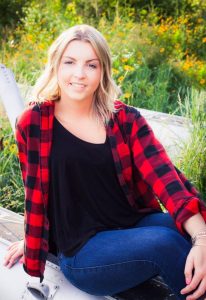
Photo courtesy Tiffany Richards
A few years ago, Tiffany walked into our office. She was planning to drop out of the nursing program and needed to make a new plan. Now this was not unusual. Every semester, I meet with several students who are “dropping out” of the nursing program; this usually means they have failed to meet the GPA requirement for a certain course and have been ejected from the major. Tiffany was one in a long string of students who had dreams of being a nurse but who found themselves needing a new plan, generally against their own wishes. But her story was different. Tiffany had a brain tumor.
Tiffany’s brain tumor meant that her short term memory was going to be affected, and that she would be unable to reliably dispense medication, so nursing was not an option for her. She had an A average in her nursing courses, and a year of foundational science education under her belt. She also had a sense of excitement about new possibilities, which is classic Tiffany. After spending time in the hospital during her diagnosis, she became interested in the role of the patient advocate who assisted her, and came to see patient advocacy as a logical and even inspiring future career path for herself. Unlike many of my students who are leaving nursing, Tiffany was excited to change her path, despite the obviously harrowing challenges that her diagnosis brought into her life.
It was Tiffany’s sense of excitement about her new path, coupled with the obvious realization that her former path was not open to her anymore through no fault of her own, that caused me to have an a-ha moment. Like a lot of my a-ha moments in education, after I had it, I was ashamed that it took me so long, since the epiphany would have been obvious far earlier had I done one important thing: looked beyond my institutional blinders to see my students as human beings.
So the epiphany was that when a student reshuffles their academic credits in the wake of an affecting life experience, education is enhanced rather than impeded. When Tiffany combined her science and nursing-specific courses with new courses in psychology and social work, this was not a bail out or a disruption; it was simply a refiguring of the horizon. Same past, new future.
Backwards Design: From Bail to Sail
But when you think of it, our educational institutions aren’t built to recognize the complexity between pasts and futures. In effect, we build superhighways with one on ramp, and lots of off ramps that lead to dead ends. At the end of the superhighway is that coast you were aiming for originally, but somewhere along the way, you decided to head into the mountains or across the plains instead, and there was no way to do it without stalling out or doubling your driving time– and who has gas to pay for that much extra time in the car? As we saw from all the hands up, life is constantly throwing up detours and crossroads, and instead of linking these to other well-lit and well-marked roadways, we assume that anyone who changes their itinerary, even for really good reasons, doesn’t deserve a worthwhile trip.
This is nuts because it’s not consistent about what we know about building knowledge, learning, growing, or succeeding. When I saw Tiffany take credits she had already completed and apply them to a different way forward, it occurred to me that this was exactly the kind of “lifelong learning” that most of our institutions claim to encourage. It was the ability to take a baseline content knowledge and propel it, through iteration and innovation, to an incrementally new area outside the bounds of what the preparation had initially focused on. Watching Tiffany refigure what she knew and identify the gaps in what she needed to know in order to pivot into new territory helped me see that this kind of iterative and constant reframing of education is a part of learning that institutions generally impede for students.
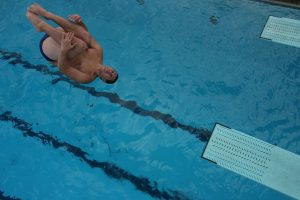 Tiffany was a sophomore when she began to shift from nursing to patient advocacy. But other students I work with are literally just a few credits shy of graduation when they need to pivot due to an obstacle or change of heart. Those students undertake the kind of backwards design that those of us who are scholars know very well. When I write a book, I have an initial topic, which morphs early into an argument or focus. I outline the book and begin to write. But the conclusion– and then indeed, the introduction– get re-honed at the end once it’s clear what the research has taught me and what I have discovered and clarified through the work process. Nobody on earth would assume that you have the entire book worked out on Day One, nor that your book would be of the highest quality if you never modified your original plan or ideas as you wrote it. We don’t call backwards design of courses or research projects “bail outs,” so why should a student who has successfully completed many course credits, who now wants to recombine them and reconfigure them to do different work, be accused of completing a “bail out degree?” This is not just a plea to stop labeling reconfiguration as a bail, it’s also about leveraging the power of this experience for student growth and for the growth of our academic fields, both of which stretch in new ways when content knowledge is coupled with an applied, high-impact learning experience. That applied, high-impact learning experience? Living a human life.
Tiffany was a sophomore when she began to shift from nursing to patient advocacy. But other students I work with are literally just a few credits shy of graduation when they need to pivot due to an obstacle or change of heart. Those students undertake the kind of backwards design that those of us who are scholars know very well. When I write a book, I have an initial topic, which morphs early into an argument or focus. I outline the book and begin to write. But the conclusion– and then indeed, the introduction– get re-honed at the end once it’s clear what the research has taught me and what I have discovered and clarified through the work process. Nobody on earth would assume that you have the entire book worked out on Day One, nor that your book would be of the highest quality if you never modified your original plan or ideas as you wrote it. We don’t call backwards design of courses or research projects “bail outs,” so why should a student who has successfully completed many course credits, who now wants to recombine them and reconfigure them to do different work, be accused of completing a “bail out degree?” This is not just a plea to stop labeling reconfiguration as a bail, it’s also about leveraging the power of this experience for student growth and for the growth of our academic fields, both of which stretch in new ways when content knowledge is coupled with an applied, high-impact learning experience. That applied, high-impact learning experience? Living a human life.
As Tiffany underwent treatment, she was still committed to staying in school. A number of students in my program have faced cancer, and many of them have appreciated the ability to keep learning even when they can’t always work at the same pace or show up for the same synchronous or face-to-face meetings.

Is this person bailing or sailing?
So my epiphany was extended as my students demonstrated that they were able to learn– often more deeply and more thoughtfully– when they were accorded flexibility as they met their life challenges. As students confronted illnesses, we started figuring out how they needed to be accommodated and then extending those accommodations into the structures of the program. We changed our grading and deadline practices to allow for more fluid and flexible schedules, since we realized our students with serious cancers were actually teaching us how to make the institution work better for all of our students, who were facing a range of crossroads and detours on a weekly basis. We changed the ethos of the program. Instead of thinking of barriers as “failures” and pivots as “bailing,” we began to ask how students could flourish, or “sail,” if they let their lives interact with their course of study with no fear that this would have to stop their learning.
Casey, Ajay, and Iterative Learning
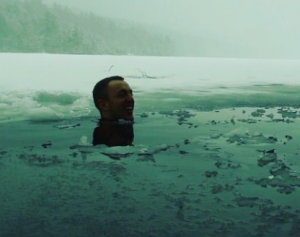
Photo courtesy Casey Smith
But this isn’t just a story about students with illnesses. Take Casey, for example. Casey is a current student in our program, creating a major in film with a focus in environmental and adventure-related film production. Casey wants to approach his studies with an eye towards building a global perspective, something he recognizes as important to the environmental issues he is most passionate about. He proposed a major that is fully iterative: each semester, he enrolls in a different study-abroad program, surveys the course offerings, and adds them to his major through a collaborative curation process with me and his other advisors. His major will likely morph in focus as his travel impacts his course selection and vice versa.
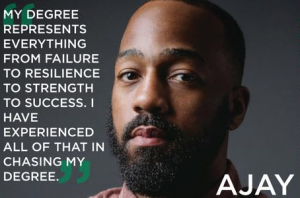
Photo by Cat Laine for College Unbound
Another example of this in action is happening at an incredible non-profit college in Rhode Island, College Unbound, which is a college completion program for adult learners, most of whom are Pell-eligible people of color, many of them working full time and raising kids. The first course these returning learners undertake is a portfolio-building class where they curate their work, life, and prior learning experiences in order to apply for equivalent college credit. They hone an individual project that they pursue throughout the curriculum, shaping the standard syllabi to their own research interests. One current student is examining how communities of color respond to diabetes education, and how health care as a category is complicated by sociological issues and material conditions. Every evening seminar begins with a hot community meal, to assure that hunger doesn’t inhibit the night’s learning and to acknowledge the logistical challenge of getting off work at 5pm and starting class at 5:30pm. Students can bring their kids with them to class, and often do. All groups are cohorted, to allow for cooperative p2p solutions (hot meals delivered for sick classmates; childcare sharing; peer tutoring and collaboration).
What’s unique about College Unbound is two-fold. First, instead of a competency- or mastery-based model that simply awards credits for the reaching of certain benchmarks, the prior learning portfolio at College Unbound is a gateway to the building of a path forward. The student’s previous failed academic record (mis-coded as such by a culture that sees “failure to complete” in these terms) combines with the student’s life experiences (often the challenges that impeded the completion of college in the first place, whether it was the need to drop out and go to work, the need to care for an ill family member, a substance abuse problem, or a million other realities), and this combination becomes the key to the student’s resilience, strength, and perspective.
It’s not some kind of charitable action to value the resilience of vulnerable and marginalized learners. The academy currently under-produces research from the margins because its institutions so often don’t make space for learners– emerging scholars– from the margins. When we do make that space, it’s not just the student who benefits, but the quality and shape of academic knowledge. Case in point, the work on diabetes health education in communities of color.
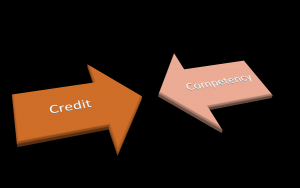
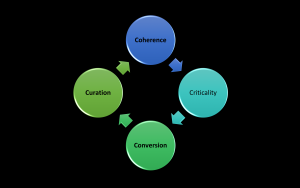
Instead of seeing student history as a data point fixed on a credit or benchmark, we see a cycle for learning that integrates with living. Now content can be curated from anywhere; positioned into interoperable coherent configurations as societal labor markets and individual passions and circumstances change; critically evaluated as time passes; and converted into iterative next steps for learning and life decisions. Students succeed, and new content is created that is both more inclusive and more complex than what we had before.
The Structural Aspects of Accommodation
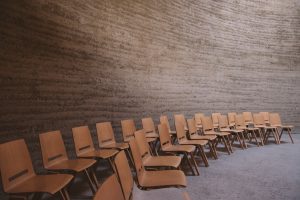 I go back and forth about whether what I am talking about here is accommodations. “Accommodate” comes from the Latin accomodatus, “to furnish with suitable room and comfort.” I like this idea. A suitable room and comfort. Creating comfort is a double-edged sword. Discomfort is an important part of learning. But there is a difference when we describe a classroom or online learning space as “safe” for LGBTQ+ people or people of color, that’s categorically different than making the space safe for homophobia or racism. Comfort works the same way. In fact, we can’t elicit or benefit from the productive discomfort of a challenge or of confusion unless we first assure a suitable and equitable level of comfort for all learners.
I go back and forth about whether what I am talking about here is accommodations. “Accommodate” comes from the Latin accomodatus, “to furnish with suitable room and comfort.” I like this idea. A suitable room and comfort. Creating comfort is a double-edged sword. Discomfort is an important part of learning. But there is a difference when we describe a classroom or online learning space as “safe” for LGBTQ+ people or people of color, that’s categorically different than making the space safe for homophobia or racism. Comfort works the same way. In fact, we can’t elicit or benefit from the productive discomfort of a challenge or of confusion unless we first assure a suitable and equitable level of comfort for all learners.
The problem is, many of us who are faculty or instructional designers start at the point at which students walk into our classrooms or online spaces. We set a place at the table for them, and work hard to make these places comfortable. But many of the conditions that make these settings deeply uncomfortable are larger than that level of course-contained pedagogy. If I made the most comfortable learning environment imaginable for you, and then asked you to meet me there tomorrow at noon, and that environment was in Perth, Australia (as far away from Toronto as we can get), it wouldn’t matter how perfect the environment was: you likely wouldn’t be there. We can’t just set the table and cook up the comfort food. How do we assure everyone can get to the table?

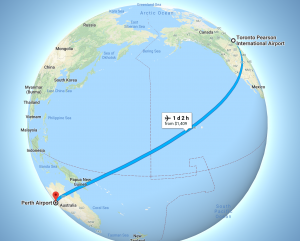
I spend a lot of time working with institutions to examine the things that prevent our students from coming to the table to learn, and I won’t go through all of them here. Suffice it to say, if you start thinking about any one issue, you immediately realize there is no logical reason not to care about all of the issues.
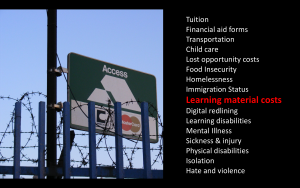
photo CCBYSA Sludge G https://flic.kr/p/7VG8oX
The reason I got invited here today, besides the fact that I routinely harassed the eCampus Ontario leadership about wanting to try Toronto’s famous Japanese cheesecake, is that I am an advocate for Open Educational Resources. But people misunderstand my commitment to lowering textbook costs. I really don’t care passionately– or even dispassionately– about textbook costs. I care about which students I fail to see at my table because they couldn’t get to Perth.
Jonathan and the Pedagogy of Access
Here’s the story of my first foray into OER. As I worked on this project with my students, I began to realize that the process of getting students to Perth is not one that is separate from pedagogy, or from my work as a faculty member. Helping students access knowledge is also about helping them gain access to knowledge creation, not just consuming information from the commons, but become participants and contributors in the knowledge commons.
(Sound off is probably better, since quality is bad, and captions are fine.)
I had such good luck addressing the textbook cost issues in ways that also contributed to learning, that I decided to listen to students and make lists of all of the reasons why they were dropping out; I read research by scholars like Sara Goldrick-Rab, and I committed not to accommodating individual students (which is sort of equivalent to America’s feel-good tendency to use GoFundMe to cover the health care costs of inspirational people with serious diseases), but to leveraging individual students’ challenges as a catalyst for integrating more flexible delivery designs into our program. This is mostly a switch from solving problems to building accessible ecosystems. And I want those ecosystems to be, categorically, ecosystems for learning.
Resisting Solutionism
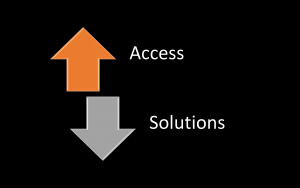 Solutions start with problems. Problems are not always tied to learners. For example, if we curtail the university’s library hours, we solve a problem in our revenue stream. But this does not increase access or help learning or our missions. If our libraries are not sustainable, we may have to make hard choices or cuts in order to assure access, but we start by assuring access, not by focusing on revenues. Other solutions are to problems that are generated by the people selling the solutions. When the textbook company, Cengage, sells us OER, they create a doubly ironic market: selling a wrapping around free materials in order to combat the high costs of textbooks, a problem that they are responsible (at least in part) for causing. Here’s Pearson using my favorite OER study to explain why faculty should choose their “inclusive access” products.
Solutions start with problems. Problems are not always tied to learners. For example, if we curtail the university’s library hours, we solve a problem in our revenue stream. But this does not increase access or help learning or our missions. If our libraries are not sustainable, we may have to make hard choices or cuts in order to assure access, but we start by assuring access, not by focusing on revenues. Other solutions are to problems that are generated by the people selling the solutions. When the textbook company, Cengage, sells us OER, they create a doubly ironic market: selling a wrapping around free materials in order to combat the high costs of textbooks, a problem that they are responsible (at least in part) for causing. Here’s Pearson using my favorite OER study to explain why faculty should choose their “inclusive access” products.
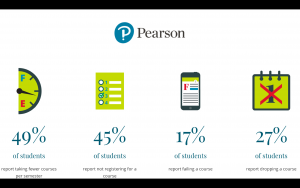
And here’s a word cloud based on words in the titles of the leadership team at Watermark, a company that sells TaskStream, a product that institutions use to collect data for accreditation (which also includes ePortfolio components for your courses). I look at this stuff, and even though I know well the “problems” that these products “solve,” I don’t like how our educational ecosystems have been boiled down to such market- and tool-centered solutions. Do the experience and background of the TaskStream leadership team match the vision they lay out in their sales pitch?
Our approach isn’t full of jargon or just about the numbers. People are at the center of everything we do. While we believe the right technology and better data can empower better learning—we know technology and data are only part of the equation. We empower institutions to engage educators and learners with better data to demonstrate and improve institutional effectiveness, program quality, and student learning.
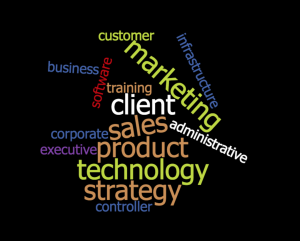
So we need a broader framework than “problem solving” for choosing our tools and paths, since problem-solving tends to be a way of isolating issues from their contexts in order to make the solutions easier to buy.
From Disruption to Praxis
If we hope to move away from a blind-faith investment in solutionism, then we need to forego the diction of “disruption” 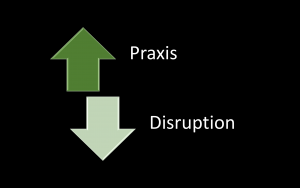 and instead steward an iterative approach grounded in praxis, or the yoking of our practice and our research. Praxis is not a thing you do once, it’s a thing you develop out of repetition and critical revision, which means that all practice informed by praxis has a history. Let’s take a look at why this matters.
and instead steward an iterative approach grounded in praxis, or the yoking of our practice and our research. Praxis is not a thing you do once, it’s a thing you develop out of repetition and critical revision, which means that all practice informed by praxis has a history. Let’s take a look at why this matters.
Here’s Anthony Levandowski, formerly of both Google and Uber, one of the pioneers behind the one tech innovation they haven’t yet tried to foist on education, the self-driving car: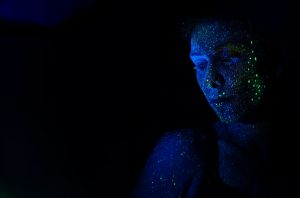
This may sound all well and good (no it doesn’t), until we look at the effects of techno-algorithmic designs that reject the lessons of history. For example, Northepointe is a for-profit company that developed the COMPAS Recidivism algorithm, in use all across the country to predict which (alleged) criminal offenders are most at-risk to re-offend; this algorithm is used in setting bond amounts and even in sentencing. The problem is that when ProPublica did a comprehensive study of COMPAS, they found that the tool proved remarkably unreliable in forecasting violent crime: only 20% of the people predicted to commit violent crimes actually went on to do so. More disturbingly (and of course unsurprisingly), they found that the formula was particularly likely to falsely flag black defendants as future criminals, wrongly labeling them this way at almost twice the rate as white defendants. Why is this? Because this algorithm is grown within the context of a racist criminal justice system. The technology solution, which appears to be neutral and simple, is complicated by the ideologies that produce it.
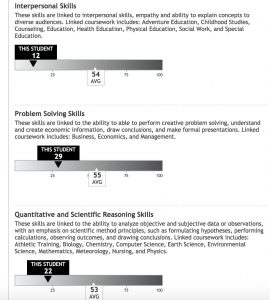 We can sometimes see this effect more easily in examples like this outside of our own educational zone. But here’s something similar from EAB, a for-profit company that “harnesses the collective power of 1,400+ schools, colleges, and universities to uncover proven solutions and transformative insights.” Essentially a data collection and analysis company, EAB sells the “Student Success Collaborative,” a product in use at more than 500 different colleges and university, which focuses on predictive analytics. My university uses SSC. Here’s an image from the opening screen that popped up when I typed in my advisee’s name.
We can sometimes see this effect more easily in examples like this outside of our own educational zone. But here’s something similar from EAB, a for-profit company that “harnesses the collective power of 1,400+ schools, colleges, and universities to uncover proven solutions and transformative insights.” Essentially a data collection and analysis company, EAB sells the “Student Success Collaborative,” a product in use at more than 500 different colleges and university, which focuses on predictive analytics. My university uses SSC. Here’s an image from the opening screen that popped up when I typed in my advisee’s name.
Predictive analytics in education are obviously cut from the same cloth as COMPAS, and we can expect both that the predictions are inaccurate in similar ways and that they are biased in similar ways. Why? Because solutions purport to solve problems by isolating data points, not by contextualizing them. And humans out of context become data points. And treating humans like data points is at best ineffective and at worse violent, oppressive, and– obviously–dehumanizing.
Scaling In: The Community Dimensions of Innovation
The first question you’re likely to be asked when you do something that seems to help your students is “does it scale?” But “scale” is about the initiative or the deliverable. Learning is about the community and the people. It happens in people rather than in external artifacts or objects (and yes, that does make it hard to measure!). This is David K. Cohen and Deborah Loewenberg Ball talking about “Educational Innovation and the Problem of Scale” (emphasis mine):
Scale is as much a qualitative as a quantitative problem. Barriers to effective implementation include the difficulty of designing innovations that are usable for teachers who have modest professional knowledge and few common professional standards, the difficulty of addressing weaknesses of capability, and the difficulty of devising means to manage the environment and support implementation. To solve the problem of ‘scaling up’ requires ‘scaling in’ –by this we mean developing the designs and infrastructure needed to support effective use of an innovation. That, in turn, requires consideration of the problems that have made some sorts of innovation difficult, and taking these into account in deciding what to change, and how to design the means to do so. It also requires significant attention to designing the use of innovations by practitioners, in the environments in which they work.
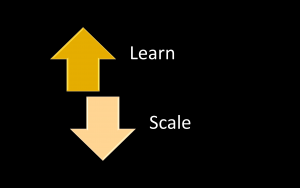 When we scale a thing, we scale it inside of communities, ecosystems. The reality of scale is that it has to be scaled in, not just scaled up. Which is why so many things fail to scale: not because they weren’t good ideas, but because we focused on more of the thing, and not how the thing interacts with the people who use it. The interaction between the initiative or innovation and the communities inside which it is embedded is the site of learning, where human communities absorb and transform new knowledge.
When we scale a thing, we scale it inside of communities, ecosystems. The reality of scale is that it has to be scaled in, not just scaled up. Which is why so many things fail to scale: not because they weren’t good ideas, but because we focused on more of the thing, and not how the thing interacts with the people who use it. The interaction between the initiative or innovation and the communities inside which it is embedded is the site of learning, where human communities absorb and transform new knowledge.
So what would it look like if we moved away from solutions and toward access? away from disruption and towards praxis? and away from scale and towards learning?
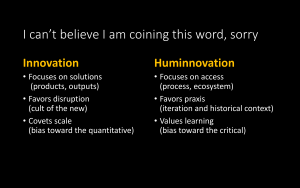
I already told you I don’t really care about textbooks. Here’s the other dirty little secret that will surprise absolutely no one. I also don’t really care about technology. And by that, I really mean, I don’t care. I care about students, about learning, about education, about where we do it and how we do it and most of all why we do it. Caring is a human quality, and I don’t know any AI that replicates it yet (whatever– don’t @ me your examples).
What I really hope you take away from this talk today is that
students are human.
Just like you and I are. Their educational paths are deeply intertwined with the realities of their lives. Perhaps you feel condescended to when I remind you of the humanity of learners, but the truth is, our institutions are rigid and inflexible, designed for the ideal learner unscathed by the challenges and passions of a human life.
We can design learning environments that not only acknowledge and accommodate the challenges and passions of learners, but leverage it as fuel for reflection and reconfiguration. We can do this by thinking of our work as ecosystem-driven, with an emphasis on access, praxis, and learning as opposed to solutions, disruption, and scaling. We can generate our innovation through our community interactions and iterations, and skeptically challenge product-based sales pitches.
Tech for a Human Future
Learning happens through humans interacting with content and, mainly, with each other. This has been a keynote focused on some stories about students, some stuff about what I have learned by teaching and by listening. I don’t know how to code. I can’t sell you an answer to the challenges you are facing now in your institutions. I worry a lot about whether we will all be ok. But I care, and I practice, and I learn. And if you ask me, it’s those of us who care and who practice and who learn who should develop the technologies of care and practice and learning that we think can serve us. Most of the tech I use now is open source, wonky, nonprofit, home grown, and indie-leaning.
Because I am not looking for a solution, you can’t sell me one.
I don’t have a problem, I have a community.
And I have a vision for how that community could better care for itself. Let’s insist on tech and on teaching that grows from what our communities need in order to expand access to knowledge and to knowledge creation. Start with who you serve, and bend your tools, your policies, and your institutions to fit them. Our human lives are troubled and violent and unexpected and thrilling and complicated, and learning takes place anyway, in spite of, and because of all this.
How beautiful would it be if our humanity wasn’t an impediment to learning, but its heartbeat?

This talk is dedicated to Tiffany Richards, 1995-2018.
Acknowledgements: I would like to thank the leadership at eCampus Ontario and the Technology Enabled Seminar and Showcase, especially Lena Patterson and David Porter, for inviting me to give this keynote. I would like to thank my students in the Plymouth State University Interdisciplinary Studies program for teaching more about education over the last three years than I had learned in the previous two decades of academic life. I would like to thank the faculty, staff, administration, and especially the students of College Unbound and the MET High Schools in Providence, Rhode Island, for some wonderfully coherent ideas about how to merge accessibility with empowerment in education. And I would like to thank my online community of colleagues in open, who are always quick to offer possibilities and pushback when I am exploring new combinations of ideas; in this instance, special thanks to Nate Angell and to all the folks on the solutionism thread on Twitter.
The slide deck from the presentation is available here.








4 thoughts on “A Human Framework for Institutional Innovation”